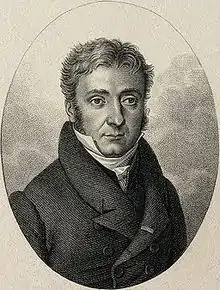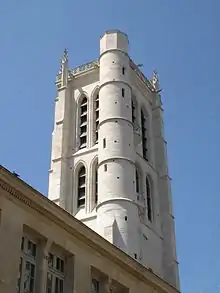Pierre Louis Dulong
Pierre Louis Dulong FRS FRSE (/duːˈlɒŋ, -ˈloʊŋ/; French: [dylɔ̃]; 12 February 1785 – 19 July 1838) was a French physicist and chemist. He is remembered today largely for the law of Dulong and Petit, although he was much-lauded by his contemporaries for his studies into the elasticity of steam, conduction of heat, and specific heats of gases. He worked most extensively on the specific heat capacity and the expansion and refractive indices of gases. He collaborated several times with fellow scientist Alexis Petit, the co-creator of the Dulong–Petit law.
Pierre Louis Dulong | |
|---|---|
 | |
| Born | 12 February 1785 Rouen, France |
| Died | 19 July 1838 (aged 53) Paris, France |
| Known for | Dulong–Petit law |
Early life and education
Dulong was born in Rouen, France.
An only child, he was orphaned at the age of 4, he was brought up by his aunt in Auxerre. He gained his secondary education in Auxerre and the Lycée Pierre Corneille in Rouen[1] before entering the École Polytechnique, Paris in 1801, only for his studies to be impeded by poor health.[2] He began studying medicine, but gave this up, possibly because of a lack of financial means,[2] to concentrate on science, working under the direction of Thénard.
Career
In chemistry, he contributed to knowledge on:
- the double decomposition of salts (1811)
- nitrous acid (1815)
- the oxides of phosphorus (1816)
- the oxides of nitrogen
- catalysis by metals (1823, with Thénard).
Dulong also discovered the dangerously sensitive nitrogen trichloride in 1811, losing three fingers and an eye in the process.[3] The fact that Dulong kept the accident a secret meant that Humphry Davy's investigation of the compound had the same unfortunate consequence, although Davy's injuries were less severe.[4]
In addition to his accomplishments in chemistry, Dulong has been hailed as an interdisciplinary expert. His contemporaries in the Royal Society of London acknowledged his "command of almost every department of physical science".[5]
In 1815, Dulong collaborated for the first time with Alexis Petit, in publishing a paper on heat expansion.[6] The two would continue to collaborate, researching the specific heats of metals. In 1819, Dulong and Petit showed that the mass heat capacity of metallic elements are inversely proportional to their atomic masses, this being now known as the Dulong–Petit law.[7] This law, though largely discredited in modern times, helped develop the periodic table and, more broadly, the examination of atomic masses.[7]
In 1818, Dulong was honored by the French Academy for work that would contribute to his co-discovery of the Dulong–Petit law.
In 1820, Dulong succeeded Petit (1791-1820), who retired due to poor health,[6] as professor of physics at École Polytechnique. Dulong studied the elasticity of steam, the measurement of temperatures, and the behavior of elastic fluids. He studied how metals enabled the combinations of certain gases.[8] He made the first precise comparison of the mercury- and air-temperature scales. In 1830, he was elected a foreign member of the Royal Swedish Academy of Sciences.
He died of stomach cancer in Paris. His is one of the names of 72 scientists inscribed on the Eiffel Tower. At the time of his death, he was working on the development of precise methods in calorimetry. His last paper, published the year of his death, examined the heat released from chemical reactions.[8]
Roberto Piazza’s 2016 paper[9] on the Dulong–Petit law provides biographical and temperament details by contemporary and fellow physicist, Jules Jamin. “Petit had a lively intelligence, an elegant and easy speech, he seduced with an amiable look, got easily attached, and surrendered himself to his tendencies rather than governing them. He was credited with an instinctive scientific intuition, a power of premature invention, certain presages of an assured future that everyone foresaw and even desired, so great was the benevolence which he inspired. Dulong was the opposite: His language was thoughtful, his attitude serious and his appearance cold[. . . ] He worked slowly but with certainty, with a continuity and a power of will that nothing stopped, I should say with a courage that no danger could push back. In the absence of that vivacity of the mind which invents easily, but likes to rest, he had the sense of scientific exactness, the gusto for precision experiments, the talent of combining them, the patience of completing them, and the art, unknown before him, to carry them to the limits of accuracy[. . . ] Petit had more mathematical tendency, Dulong was more experimental; the first carried in the work more brilliant easiness, the second more continuity; One represented imagination, the other reason, which moderates and contains it.”
Personal life
He was married to Emelie Augustine Riviere in 1803.[10]
Socially, Dulong was often dismissed as a dry, standoffish individual. His few friends disagreed with this view, viewing his personality as subdued rather than dull.[6]

Dulong was noted both for his devotion to science and the stolid, almost casual, bravery he displayed in prosecuting his experiments. One such experiment involved the construction of a glass tubular apparatus atop the tower at the Abbey of St. Genevieve. The tower was unsteady enough that an explosion of the experimental materials, considerably likely considering their volatility, could easily have toppled the tower and killed the researching physicists, including Dulong. The experiment though "full of danger and difficulty", was completed under Dulong's leadership.[11]
Another example of Dulong's indifference to danger amid scientific pursuit came about in his studies into nitrogen trichloride. Despite losing two fingers and one eye in his initial experiments, Dulong continued to research the unknown substance. His inquiry led to more injuries, after which he turned over the results of his studies to Sir Humphry Davy.[6]
Death
In life, Dulong poured the bulk of his finances into his scientific experiments. He was often destitute. As a result, he died without leaving his family any significant inheritance.[6]
He is buried in Père Lachaise Cemetery. His monument was paid for by his scientific peers.[6]
References
- Lycée Pierre Corneille de Rouen - History
- Fox, Robert (1968). "The Background to the Discovery of Dulong and Petit's Law". The British Journal for the History of Science. 4 (1): 1–22. doi:10.1017/s0007087400003150. JSTOR 4024983.
- Thénard J. L.; Berthollet C. L. (1813). "Report on the work of Pierre Louis Dulong". Annales de Chimie et de Physique. 86 (6): 37–43.
- Hale, William (April 1888). "Formation of the Explosive Chloride of Nitrogen by Electrolysis". Science. 11 (273): 206. Bibcode:1888Sci....11..206H. doi:10.1126/science.ns-11.273.206. JSTOR 1764740. PMID 17806755.
- Britain), Royal Society (Great (1837-01-01). Abstracts of the Papers Printed in the Philosophical Transactions of the Royal Society of London. Richard Taylor.
- Lemay, Pierre (1948). "Pierre Louis Dulong, His Life and Work". Chymia. 1: 171–190. doi:10.2307/27757122. JSTOR 27757122.
- Laing, Mary; Laing, Michael (2006). "Dulong and Petit's Law: We Should Not Ignore Its Importance". Journal of Chemical Education. 83 (10): 1499–1504. Bibcode:2006JChEd..83.1499L. doi:10.1021/ed083p1499.
- "Pierre-Louis Dulong | French scientist". Encyclopedia Britannica. Retrieved 2017-05-05.
- The strange case of Dr. Petit and Mr. Dulong, Roberto Piazza, arXiv, 2018-07-06
- Biographical Index of Former Fellows of the Royal Society of Edinburgh 1783–2002 (PDF). The Royal Society of Edinburgh. July 2006. ISBN 0-902-198-84-X.
- Chisholm, Hugh, ed. (1911). . Encyclopædia Britannica. 08 (11th ed.). Cambridge University Press.
Further reading
- Petit, Alexis-Thérèse; Dulong, Pierre-Louis (1819). "Recherches sur quelques points importants de la Théorie de la Chaleur". Annales de Chimie et de Physique (in French). 10: 395–413. English translation: "Research on some important aspects of the theory of heat" from Annals of Philosophy 14, 189 – 198 (1819).
External links
- Chisholm, Hugh, ed. (1911). . Encyclopædia Britannica (11th ed.). Cambridge University Press.